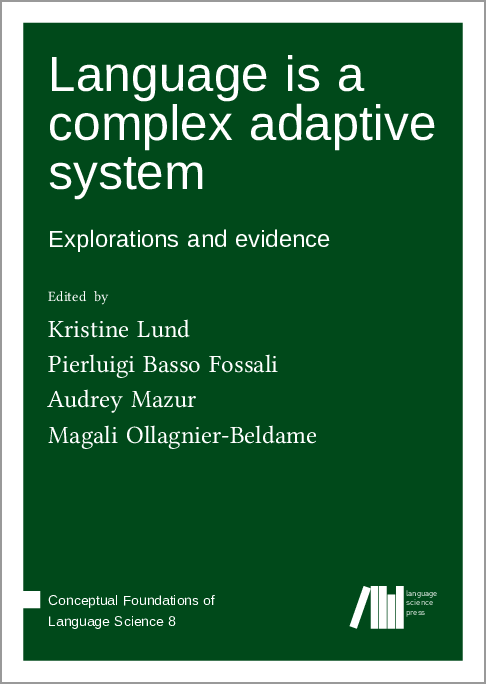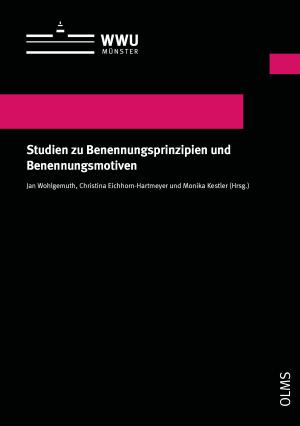In der letzten Zeit sind u.a. diese frei verfügbaren Titel erschienen:
Language is a complex adaptive system: Explorations and evidence
Kristine Lund / Pierluigi Basso Fossali / Audrey Mazur / Magali Ollagnier-Beldame
https://langsci-press.org/catalog/book/334 & https://doi.org/10.5281/zenodo.6546419
The ASLAN labex — Advanced studies on language complexity — brings together a unique set of expertise and varied points of view on language. In this volume, we employ three main sections showcasing diverse empirical work to illustrate how language within human interaction is a complex and adaptive system. The first section – epistemological views on complexity – pleads for epistemological plurality, an end to dichotomies, and proposes different ways to connect and translate between frameworks. The second section – complexity, pragmatics and discourse – focuses on discourse practices at different levels of description. Other semiotic systems, in addition to language are mobilized, but also interlocutors’ perception, memory and understanding of culture. The third section – complexity, interaction, and multimodality – employs different disciplinary frameworks to weave between micro, meso, and macro levels of analyses. Our specific contributions include adding elements to and extending the field of application of the models proposed by others through new examples of emergence, interplay of heterogeneous elements, intrinsic diversity, feedback, novelty, self-organization, adaptation, multi-dimensionality, indeterminism, and collective control with distributed emergence. Finally, we argue for a change in vantage point regarding the search for linguistic universals.
Respiratory health sensing from speech
Venkata Srikanth Nallanthighal
https://doi.org/10.48273/LOT0626
Speech production is a complex process involving multiple systems, including cognitive, muscular, and respiratory systems. Perfect synchrony among these systems is essential; any lapse in the synchrony would lead to a disorder manifested in one’s speech. Thus, speech is a good pathological indicator. Respiration is an essential and primary mechanism in speech production. We first inhale a gulp of air and then produce speech while exhaling. When we run out of breath, we stop speaking and inhale. Though this process is involuntary, speech production involves a systematic outflow of air during exhalation characterized by linguistic content and prosodic characteristics of the utterance. Modeling the relationship between speech and respiration makes sensing respiratory dynamics directly from the speech plausible. Modeling such a relationship is not easy and direct because of the complex nature of speech and respiration. However, machine learning and deep learning architectures enable us to model such complex relationships.
In this thesis, we conduct a comprehensive study to establish the relationship between speech and respiration. We explore techniques for sensing breathing signals and breathing parameters from speech using deep learning architectures and address the challenges involved in establishing the practical purpose of this technology.
Our main conclusion is that breathing patterns might give us information about the respiration rate, breathing capacity and thus enable us to understand the pathological condition of a person using speech conversations. This would help early and remote diagnosis of various health conditions. Estimating breathing signal and parameters from the speech signal is an unobtrusive and potentially cost-effective option for long-term breathing monitoring in telehealthcare applications.
Studien zu Benennungsprinzipien und Benennungsmotiven
Jan Wohlgemuth / Christina Eichhorn-Hartmeyer / Monika Kestler
https://doi.org/10.17879/92039675704
Dieser Sammelband widmet sich in sechs Beiträgen verschiedenen Aspekten der synchronen Etymologie, insbesondere der Untersuchung von Benennungsprinzipien nach C.-P. Herbermann. Dabei wird ein Bogen geschlagen über den (indo-)europäischen Vergleich der Benennungen von Farbwörtern und derjenigen von Wochentagsnamen, sowie deutsche Krankheitsbezeichnungen auf „-fieber“. Zwei metalinguistische Beiträge befassen sich mit der grammatischen Terminologie ’starke‘ vs. ’schwache‘ Flexion und den semantischen Strukturen von Sprachennamen in aller Welt. Ergänzt wird die Sammlung durch eine Einzelwortanalyse aus dem niederländisch-javanischen Sprachkontakt.
Verbindendes Element ist die Suche nach Benennungsprinzipien, d.h. wiederkehrenden semantischen Mustern, mittels derer Dinge benannt werden. Diese Forschungsrichtung hat in Münster eine lange Tradition. Mit dem vorliegenden Sammelband wurde ein Versuch unternommen, diese in der deutschen Philologie verwurzelte Tradition auf eine breitere, allgemeinlinguistische Basis anzuwenden, um ihr dadurch neue Impulse zu geben.



